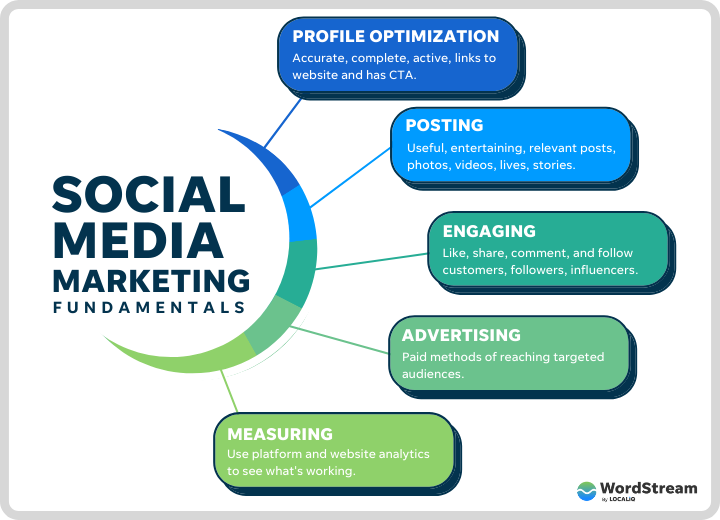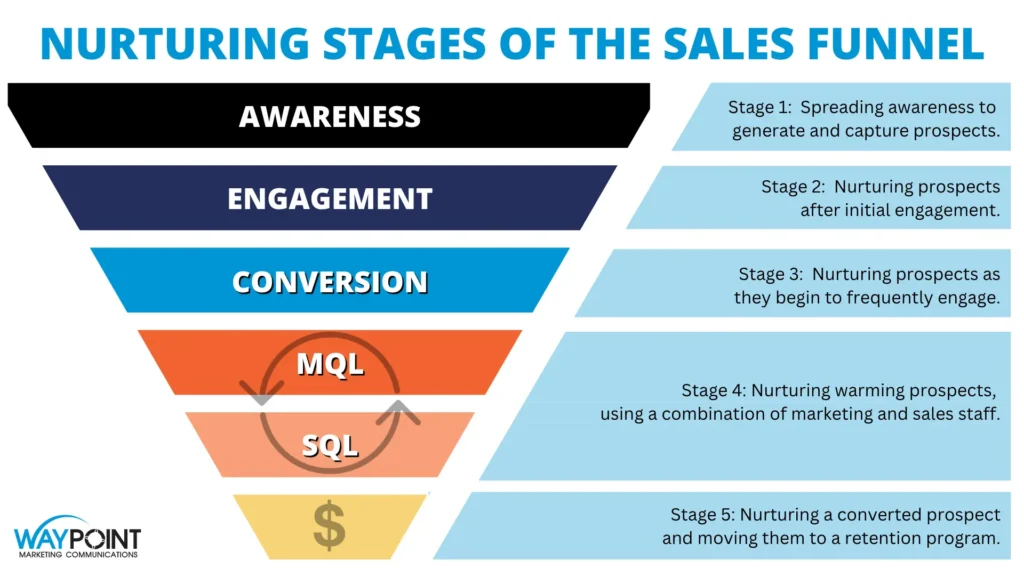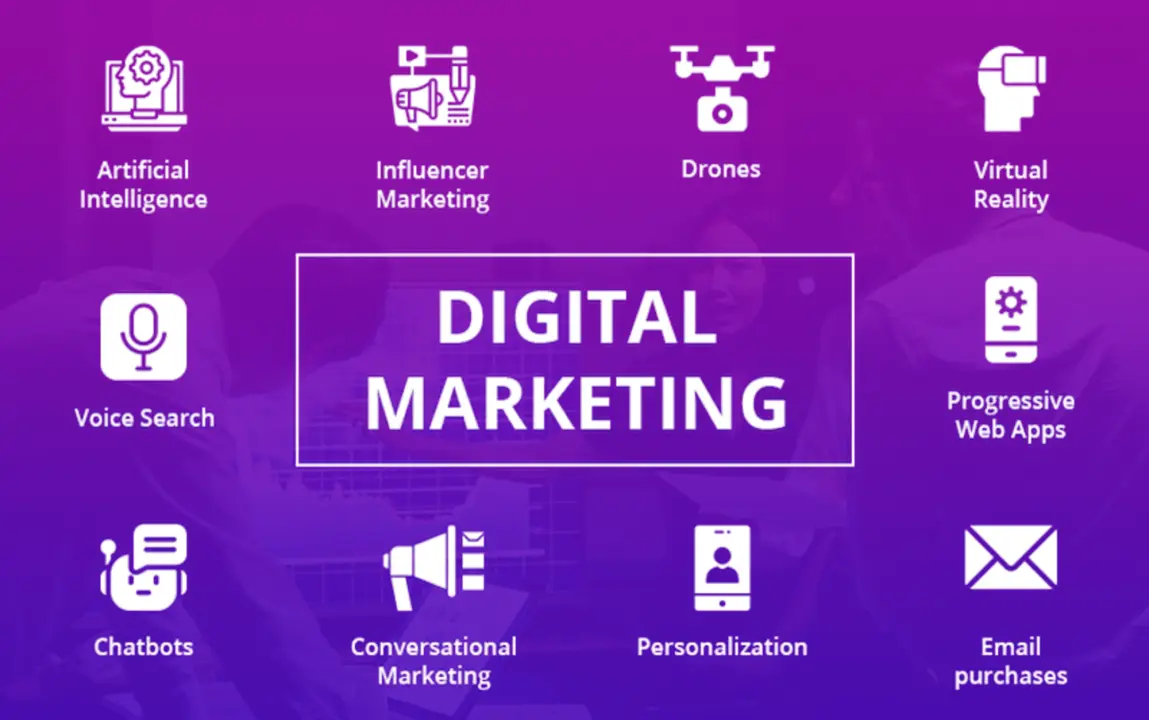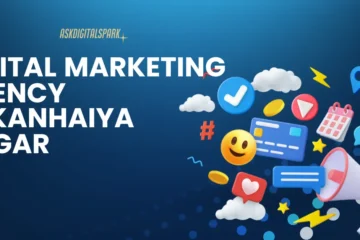Introduction: The development of digital marketing
In the previous decade, digital marketing has undergone significant evolution, and it is no longer limited to advertisements on websites or banners popping up. By 2024, digital marketing will be even more crucial due to the increased competition for customers’ attention among enterprises worldwide.
Companies who want to be at the forefront of digital marketing must first comprehend the tool’s fundamentals and growth. In this blog, we will explore the most important techniques and phenomena determining the future of digital marketing and provide vital information to help you create a good marketing plan.

Designing a Web Presence Marketing Plan
An efficient digital marketing strategy outlines the road map for achieving your business goals online. It includes numerous crucial steps: It includes numerous crucial steps:
• Identifying Your Target Audience: The first step is to understand your target clients, what they need, and where they are most active on social media.
• Setting Clear Objectives: Your goals should have the following characteristics: SMART goals are specific, measurable, achievable, relevant, and time-bound. If you want to focus on branding, traffic, or conversions, you must establish work objectives.
• Choosing the Right Channels: Depending on your target audience, you may want to prioritize SEO, content marketing, social media, email, and PPC advertising. All channels have advantages, which is why they should be used properly.
• Developing a Content Strategy: When it comes to digital marketing, everything revolves around content. Having a content calendar based on the audience’s demands and interests, as well as the enterprise’s goals and objectives, aids in the daily publication of relevant material.
• Monitoring and Optimization: By regularly monitoring and evaluating the results of your digital marketing, you may gain objective feedback on your success and adjust and enhance your strategy accordingly.

Content Marketing as a Tool in Modern Digital Management
It is worth noting, however, that content marketing remains one of the most influential strategies employed by today’s digital marketing. It uses intellectual and physical resources to create and disseminate valuable information to a targeted audience. Here’s why it matters:
• Building Brand Authority: By creating consistent, high-quality content that provides value to your target audience through knowledge or entertainment, your company becomes a go-to source for the information they are likely to require. This is critical in the establishment of trust and credibility, both of which are important aspects in establishing consumer loyalty.
• Driving Organic Traffic: Optimizing content can go a long way toward ensuring that one is listed well in search engines, making it easy for potential clients to find your company online. To increase viewability and traffic, all material created must constantly adhere to SEO best practices.
• Supporting the customer’s Journey: Content must be embraced at every level of the buyer’s journey hierarchy. Everyone is striving to generate material that walks the prospect through the funnel, from awareness (blog posts, infographics) to consideration (case studies, whitepapers) to conviction (product comparisons, testimonials).
• Fostering Engagement: Using graphic and technologically based content such as films, podcasts, and webinars allows for a deeper touch with the target audience. Because of the popularity of social media apps like TikTok and Instagram Reels, short films are an effective approach to capturing the audience’s attention.

SEO and SEM: Promoting Awareness and Visits
SEO and SEM are two of the most significant activities in digital marketing because they help boost website rankings and traffic to your site.
• SEO Fundamentals: SEO is all about improving your web page and the content you submit so that it ranks higher in SERPs. This also includes on-page SEO (i.e., meta tags, keywords, content layout), technical SEO (for example, site speed, mobile-friendliness, security), and off-page SEO (e.g., backlinks, social media).
• Local SEO is vital for organizations with a physical location. There are many options for improving your Google My Business profile for local SEO, including getting positive ratings and using the same NAP (Name, Address, and Phone number) as your website.
• SEM and PPC: SEM includes the PPC advertising approach, which requires bidding for certain keywords to be displayed as a sponsored link on search engines. It is one of the quickest ways to send targeted visitors, but it requires significant control over keywords, ad text, and, in most cases, the destination page to achieve a positive ROI.
• Analytics and Optimization: Website analytics tools like Google Analytics and SEMrush can assist you monitor performance, behavior, and trends, as well as develop SEO and SEM over time. Quarterly updates to the strategy based on these insights maintain it competitive.

Using Social Media Marketing to Facilitate Brand Development
Customer involvement is no longer an impossible goal thanks to social media platforms, which are important for brand development. To properly use social media marketing, firms must: To properly use social media marketing, firms must:
• Choose the Right Platforms: However, not every social media site will be appropriate for the brand you are selling. Identifying the platforms requires knowing where your audience is, whether it is on Facebook, Instagram, Linked In, Twitter, or the new kid on the block, TikTok.
• Content Tailoring: Each of them has its own content type and visitor behavior. For example, Instagram is popular for posting images and short videos, whereas LinkedIn, a professional networking site, is ideal for sharing articles and opinions. There is one crucial rule: always aim to create and publish content that will be particularly effective on each platform.
• Engagement and Interaction: Social media is not a medium for pushing your message; it is all about relationships, or more specifically, relationship building. Perceiving messages, responding to comments, continuing conversations, and expressing gratitude to one’s followers all contribute to the development of a follower community.
• Paid Social Media Advertising: On social media, there are many effective advertisement placement options where one may create targeted adverts based on who, what, where, and how. Paid commercials enable businesses to reach new audiences, raise brand awareness, and increase sales.

Email marketing: Lead generation and nurturing.
In as much as new kinds of marketing have evolved as a result of the internet, e-mail marketing remains one of the most effective ways of handling leads to turn those leads into customers. Here’s how to realize its full potential: Here’s how to realize its full potential:
• Building a Quality List: It is critical to recognize that the list is the most crucial component of any successful email marketing campaign. Many lead magnets, such as e-books, webinars, and discounts, can also be leveraged to increase subscriber numbers. Use a thorough email list to ensure that it is organized by the customer’s preferences and behaviors.
• Crafting Compelling Emails: To guarantee that the emails you send are engaging and on the ‘do’ list, you should consider the following points: Ensure that the subject lines, greetings, and message formatting are all appropriate because they are possible motivators. It is also crucial to include visuals like images and movies in order to improve engagement.
• Automation with Drip Campaigns: Email automation allows you to send an email as a follow-up to certain activities (for example, welcoming emails or reminders that customers left things in their carts). Drip campaigns are most effective for nurturing a lead over time and feeding him or her with sales funnel-friendly material.
• Analyzing and Optimizing: Consider the frequency of enhanced email campaign analysis and various parameters such as open rates, click-through rates, and conversion rates. Identify trends and use them to fine-tune schemes and test various components of a campaign in order to maximize its efficacy.

The Future of Digital Marketing: The Trends to Monitor
As a result, people can argue that the ongoing growth of technologies parallels the constant development of the digital marketing environment. Being able to combat emerging trends may help you compete with other businesses. Some major trends to watch in 2024 are: Some major trends to watch in 2024 include
• AI and Personalization: With artificial intelligence at the forefront, digital marketing is becoming more personal than ever. Artificial intelligence can process enormous amounts of data to deliver personalized experiences for a large number of customers, ranging from product selection to email content.
• speech Search Optimization: As more people use speech-activated devices like the Amazon Echo and Google Home, optimizing for voice search becomes increasingly important. As a result, the importance of paying close attention to task-focused conversational keywords should not be underestimated, but rather supplemented by other best practices such as ensuring that the material answers queries concisely and clearly.
• Sustainability and Ethical Marketing: Today’s consumers are more aware of the businesses they support, particularly when the latter have discouraged the use of better products and methods. Marketing and encouraging brand initiatives toward sustainability may be effective for today’s aware customers.
• Metaverse and Virtual Reality (VR): The creation of a new collective virtual realm, known as the metaverse, is opening up new potential for digital marketing. Some firms have provided their customers with virtual reality experiences and virtual shops, indicating that contact is not limited to the Internet.
• Data Privacy and Compliance: This is due to a growth in rules governing the management of customer information, such as GDPR and CCPA. Recognizing people’s rights to share their knowledge will also be vital if firms want to establish trust as customers become more educated.

Conclusion
To stay ahead of the competition in 2024, marketers must combine tried-and-true strategies with new ones. Businesses may orchestrate their performance on the ever-changing digital playing field by focusing on these six important components: strategic consultation, content marketing, SEO/SEM, SMM, emailing, and major trends.
Whether you’re seeking to optimize an existing plan or start from scratch, focusing on the following elements can help you succeed consistently in the digital environment.
In this blog, the main aspects of digital marketing are discussed, along with overviews that will assist the reader in answering questions about the current status of the market and future trends.
What is a digital marketing strategy?
A digital marketing strategy is a comprehensive plan that outlines how you will use digital channels to achieve your marketing goals. It includes setting objectives, identifying target audiences, choosing appropriate platforms, and measuring performance.




